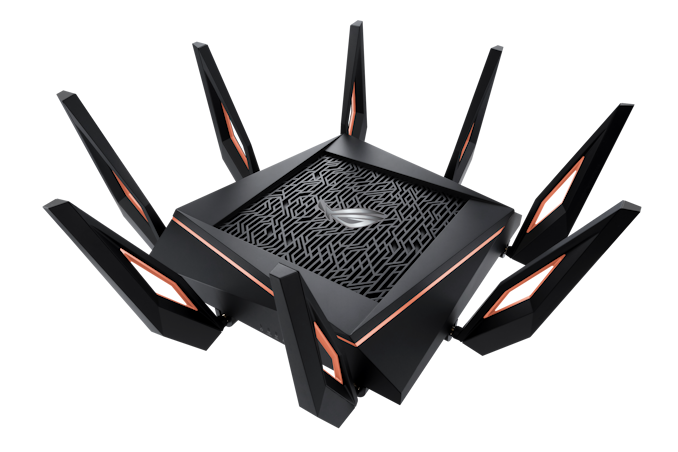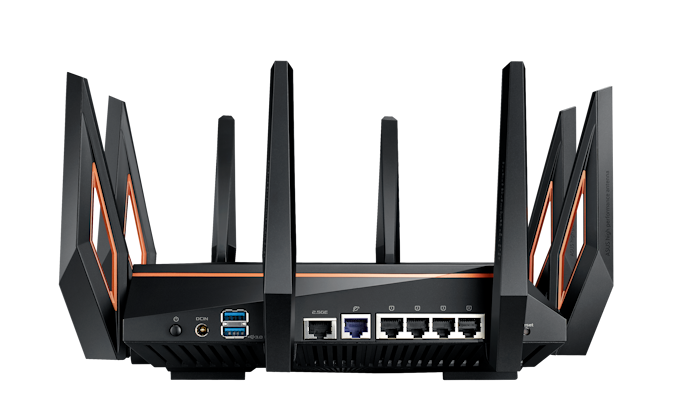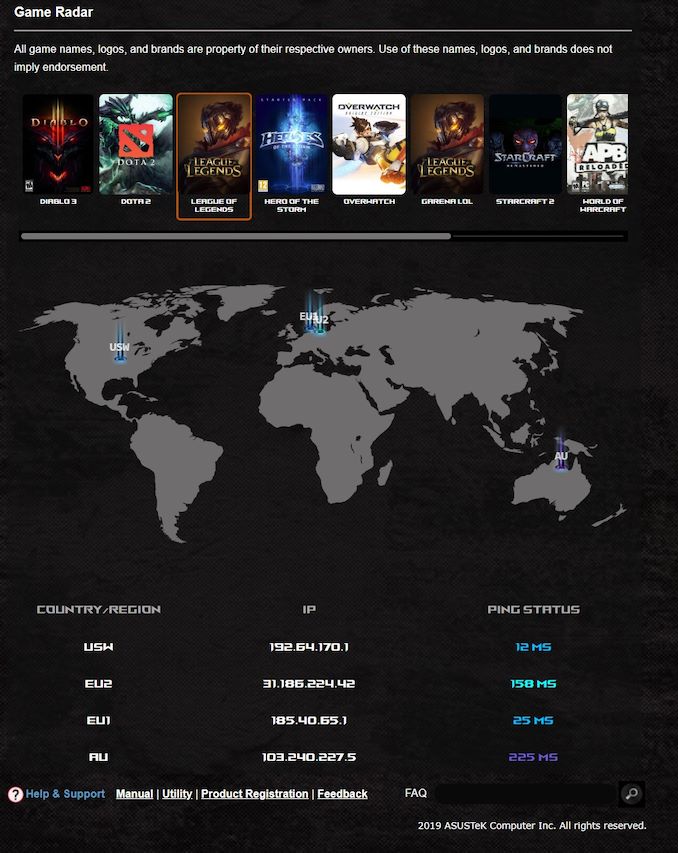AT 101: Wi-Fi 6 And Why You Want It
by Brett Howse on February 12, 2020 8:00 AM ESTThe 2020 AnandTech Wi-Fi Test Bed
We’ve been comfortably using Wi-Fi 5 for some time now, and it is only in the last several months that laptops have been shipping with Wi-Fi 6 based networking, mostly thanks to Intel’s Project Athena which has a requirement of the Intel AX200 Wi-Fi module, which is Intel's first Wi-Fi 6 based module on the market. Previously almost all shipping laptop computers offered Wi-Fi 5, and even a few with the latest Intel wireless adapters such as the Wireless-AC 9260 offered the advanced Wi-Fi 5 options such as 160 Mhz channel width, and MU-MIMO, so its nice to see a move to a new standard which includes these benefits across the board.
Although there are now quite a few Wi-Fi 6 routers and access points on the market, we had some specific criteria to meet. The router had to support Wi-Fi 6, and the 160 MHz channels, but because we are testing for performance, and not for capacity, we need an access point with a multi-Gigabit Ethernet connection. A typical laptop with a 2x2:2 network connection will be connecting to the access point at 2.4 Gbps, so transferring files from Ethernet over Gigabit will be a bottleneck. This does limit the selection somewhat.
After evaluating several models, we decided on the ASUS ROG Rapture GT-AX11000. The name is a mouthful, but meets all of our criteria and more. Most importantly, it offers the coveted 2.5 GbE port.
The ASUS ROG Rapture GT-AX11000
As the name implies, this router from ASUS can support up to 11000 Mbps over wireless, thanks to the 4x4 2.4 GHz, offering 1148 Mbps, and the two 4x4 5 GHz networks each offering 4804 Mbps. This adds up to just under 11000 Mbps, although with wireless the maximum connection speed is pretty much impossible to achieve. With the two separate 5 GHz networks, you can easily split off your consumption devices with higher priority devices, reducing interference on each network.
On the Wide Area Network (WAN) side there is a single 1 Gbps connection, and on the Local Area Network (LAN) side there are four 1 GbE and the single 2.5 GbE connection.
This router is built for capacity, with eight external antennae, and being a gaming router it also offers plenty of RGB lighting options. For those that don’t need the lighting, it can be turned off. ASUS also some tools to change the priority of gaming packets to reduce latency, assuming your network is that busy, and specifically prioritizes traffic from other ROG devices to make setup as easy as possible. ASUS even includes a utility to ping the various game servers for popular multiplayer games to provide you a map of latency to each one.
The GT-AX11000 also integrates with the ASUS AiMesh networking equipment to provide a whole-home mesh network, if even a router of this size can’t cover the entire house, either due to size or building materials blocking the signal.
For testing, the router is used in the access point mode, with the LAN connecting being over the 1 Gbps Ethernet, and a server connected directly to the router in the 2.5 Gbps port.













149 Comments
View All Comments
ksec - Wednesday, February 12, 2020 - link
Not only that. ( OFDMA It has compatibility problems and remains to be seen whether it works given the limitation ) It will likely end up like MU-MIMO where the benefits drops once you have non-MU-MIMO devices in the same location. ( i.e useless )160Mhz and 80+80Mhz are still optional. Meaning you wont get those sort of speed in vast majority of cases, no current 802.11ax Smartphone support 160Mhz or 80+80Mhz Channel. ( Both Samsung and iPhone ) Although Intel ( if I remember correctly ) do support 160Mhz, but then they decided to stop making 3x3 config for Laptop.....
WiFi 6E had the best chances to remedy all of this. But nope, all those features are still optional.
There were a few other features missing from the spec, oh I forgot to mention the spec is still in Draft as it has been delayed yet again.
The whole thing is a bloody pile of mess.
PaulHoule - Wednesday, February 12, 2020 - link
My experience with WiFi performance in the real world is that nothing beats having multiple access points and spreading the clients between them. Performance is just so much better when clients aren't fighting each other for access to the net, and this counts particularly for internet connections to the outside, where the most important WiFi parameter is packet loss.I am waiting for UNBT to come out with a WiFi 6 access point which is reasonably priced, and for that matter, to get any cliets that support WiFi 6.
digitalgriffin - Wednesday, February 12, 2020 - link
True Paul. I segment my network. I have a subnet for smart devices with it's own AP running on a unique frequency. I have another subnet for my streaming devices with it's own AP. It not only allows me to save bandwidth for more critical devices, but also allows me to monitor on a more granular level for data usage and potential hacking hijinx.The only disadvantage to this method is my android devices can no longer directly access devices like Roku.
imaheadcase - Wednesday, February 12, 2020 - link
This article is so silly.First the title says "why you want it". Then later it says "maybe". Then it shows "benchmark" for unrealistic speeds, with limited devices to test.
Then it totally glosses of the fact that its not worth it AT ALL if other devices are not the same spec.
Considering %99 of devices that come out are 2.4Ghz still, including top of the line cameras zero reason to upgrade to this.
I'm thinking the article was just put up for the ad revenue for the clicks.
Oh lets not even go over how they talk about the progression of the wireless standard that takes forever to ratify, it its speeds are still really weak when it comes to LAN.
Unless you live in an area impossible to wire with LAN, no reason to go wireless. I'm my experience in a PoE camera is even better than wireless camera setup!
PeachNCream - Wednesday, February 12, 2020 - link
Yes, the article title is was poorly thought out to say the least. I'd prefer if the facts were presented as facts and the decision about whether or not I wanted something would reside in opinions I form after the fact. Telling me I want something is somewhat narrow thinking.GreenReaper - Friday, February 14, 2020 - link
This is a problem with the whole "thought leader" aspect of journalism. At least they could leave open the possibility that you might *not* want it. Right now, on the face of it, that's not an option.Dug - Wednesday, February 12, 2020 - link
What does some walls mean? Can you please tell us how many walls, what kind of wall, height of ceiling, and the distance? In my mind you are saying that you are 3 rooms away? How big are the rooms? Or is it a hallway wall without doors?If you are going to have a "test bed" it would be nice to know the layout so we can judge if it matches our environment.
Thanks.
DanNeely - Wednesday, February 12, 2020 - link
agreed. Arstechnica posts floorplan diagrams for their wifi testing articles; which comes in particularly useful for testing mesh network kits with variable numbers of boxes.ascott.neu.edu - Wednesday, February 12, 2020 - link
how does dynamic fragmentation work? i.e, are packets reassembled before being sent to the internet, or are the fragments reassembled at the destination? most systems try to avoid fragmentation, as it requires reassembling packets, and actively try to identify the largest packet that can be sent without fragmentation. dsl usually required smaller packets to avoid fragmentation, as i recall. Gigabit "ethernet" is switched. no interference from others using the same network. store and forward, almost always delivers packets. wifi is more old school csma/ca, which isn't even as good as old fashioned csma/cd ethernet. collisions detected in hardware rather than waiting for ack/nak. No matter how fast your wifi is, there are still shared resources that may very well limit your throughput and latency to resources on the internet.damianrobertjones - Wednesday, February 12, 2020 - link
"Wi-Fi 6 And Why You Want It"I don't actually want this.